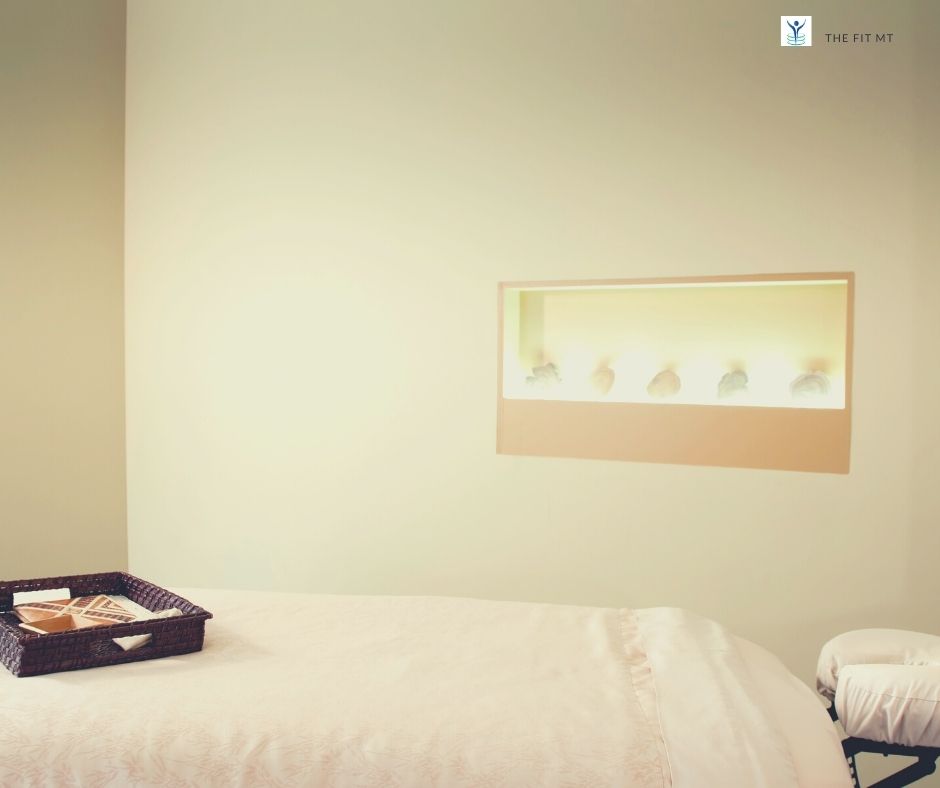MASSAGE THERAPIST LOW BACK PAIN TREATMENT AND PREVENTION Self Care for in between clients and at the end of your workday.

As massage therapists, we work with clients using our bodies all day long to provide relief and relaxation to others.
At times, our own body's signs of fatigue go overlooked until we feel pain or discomfort. Low back pain or tightness can really hinder our focus on clients and make our massage less than great.
Why is your back hurting?
Improper table height
The first signs of back tightness may be because your table height is off. When working with a table that is too low, it's easy to slouch or bend forward towards our work on the table instead of getting lower in our stance using legs.
Always check your table height at the beginning of your day and make adjustments. The rule of thumb for table height is when standing next to the table with a loose fist, your first knuckles should just brush the top of the table.

Another possibility contributing to your low back pain is a weak or unengaged core.
Weak core muscles
The core of our body is the center of all movements we perform. Whether it's getting out of the car or walking downstairs, our core stabilizes our limbs and maintains our balance.
It's natural then, to use our core at the massage table when in a bow stance, using an effleurage stroke down a client's back.
What isn't natural is to perform 6-8 massage sessions a day, most days of the week. This workload requires extra strengthening of the core to prevent injury.
This means direct abdominal exercises as well as indirect core exercises. This could look like crunches, planks, or squats.
What does an engaged core feel like?
When you engage the core, you tighten or contract the muscles through the center of your body. Think of pulling your belly button in towards your spine.
Another way to engage the core is to contract the center of your body, like when performing a crunch on the ground.
Engaging your core while you give massages throughout the day will protect your low back and prevent pain. It will also provide a strong base before lifting a client's leg for range of motion or performing a stretch for a client.
At the massage table, an engaged core makes your strokes feel more balanced, fluid and connected. Often, clients won't know why your massage is better than others but they will feel a difference.
Self-care for low back pain
Stretch
Stretching is one of the easiest and best preventions of low back pain. Catching tightness and relieving it before it becomes pain is the goal for massage therapists. Try these low back stretches at the end of a workday or in between clients.
1. Squat stretch
Come into a squat, holding onto a piece of furniture or something in front of you if needed for balance. If a full squat is too much for your knees, try number 4 on this list.

2. Knees to chest
Lying on the floor, curl up into a ball, hugging your knees towards your chest. Hold, breathe and rock slowly side to side feeling for tightness.
3. Spinal rotation
Some prefer this stretch lying down but it can also be done seated. Sit with your spine stacked tall and twist as far as you can one way, looking behind you and repeat on the other side.
While lying on the floor, from a supine position, take one leg across the midline of the body to rest on the opposite side. Repeat on the other side.
4. Bent knee hang
The key to this stretch is to bend the knees slightly to remove the hamstrings from the equation, bend forward and hang, sacrum high, swaying gently side to side feeling for tightness.
Rejuvenate
Part of good self-care for massage therapists is giving your body time to rejuvenate. If you want your body to continue serving you, allowing you to do what you love, then you need to give back.
This could be an additional day off when you've worked extra clients in a week, or getting a massage yourself, or doing a simple restorative exercise like the one below.
Lie on the floor with your legs up a wall. Scoot as close to the wall as you can before putting your legs up the wall.

This restorative exercise is good for low back pain or when you feel back fatigue.
Strengthening the core to prevent low back pain
Building strength is the number one way to prevent overuse injuries and pain. When your muscles are strong enough to sustain the workload you ask of your body, you may get fatigued but you won't get injured.
You'll still need self-care but you won't burn out physically.
Remember the core includes back muscles as well as abdominal and oblique muscles. Here are some ideas of core strengthening exercises you can do to keep massaging as long as you desire.
- superman
- crunches
- bicycles
- crunch twists
- planks
Knowing how to prevent low back pain is helpful and catching signs of tightness before pain sets in is critical to a massage therapist's career longevity.
Until next time,
Be fit, be strong and give your low back some love

Want to know the latest happenings around The Fit Massage Therapist?
Come hang with us, where we are happy and massaging pain-free.
Don't worry, your information will not be shared.




